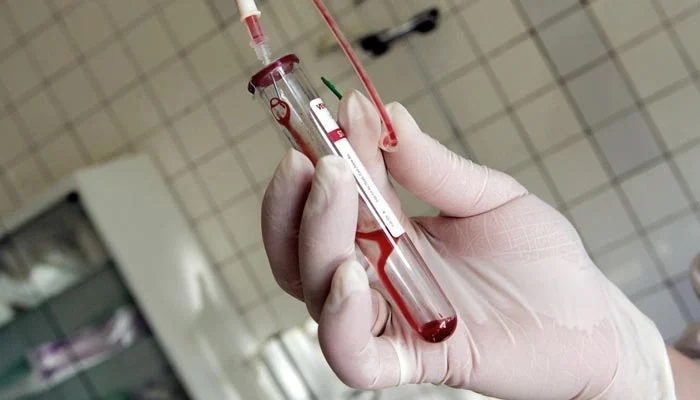- Newly infected people include low risk males, females, clients of key populations.
- Punjab tops in new HIV cases with 6,106 people infected.
- Doctor says healthcare system biggest culprit in spreading HIV in Pakistan.
ISLAMABAD: As many as 9,773 people have tested positive for HIV in Pakistan during the last 10 months of 2022, raising serious doubts about HIV prevention and control efforts and clearly indicating spread of HIV from the key populations to the general public, health authorities in the federal capital said, citing official data.
“Every month, more or less 1,000 new HIV cases are being reported from all four provinces, capital Islamabad, Azad Kashmir and Gilgit Baltistan. This clearly indicates that HIV is now spreading to general population from the key populations including people who inject drugs, male, female and transgender sex workers,” an official of the National Health Services, Regulations and Coordination (NHSR&C) told The News.
Pakistan has spent hundreds of millions of dollars from the Global Fund and other international donor agencies during the last 11 years to contain and prevent the spread of HIV but new infections are constantly on the rise. According to UNAIDS, a significant percentage of low risk males, females, and clients of key populations are the newly infected ones suggesting an increase in HIV transmission to bridging populations (spouses, partners, and clients) of key populations.
Official data available with The News indicate that Punjab tops in new HIV cases where 6,106 people have been tested positive from January to October 2022, followed by Sindh where 2,097 people have been tested positive for HIV in the last 10 months, while 815 new HIV cases have been reported from Khyber Pakhtunkhwa in the current year till October 31, 2022.
Similarly, 316 new HIV cases have been reported from Balochistan while 496 new HIV cases have been reported from Islamabad Capital Territory (ICT) from January to October 2022, the official data indicates.
In Punjab, which is the most affected province with respect to HIV in Pakistan, 400 people were tested positive in January, 475 in February, 572 in March, 547 in April, 610 in May, 723 in June, 669 in July, 701 in August, 712 in September and 697 in the month of October 2022, the official data shows.
With 2,097 new cases 10 months of current year, Sindh was second with new HIV cases where 164 cases were reported in January, 148 in February, 182 in March, 201 in April, 183 in May, 211 in June, 181 in July, 169 in August, 236 in September and 140 new cases were reported in October 2022, the official data indicates.
Khyber Pakhtunkhwa had 815 new HIV cases in the first 10 months of the current year with 71 new cases reported in January, 96 in February, 71 in March, 61 in April, 68 in May, 85 in June, 84 in July, 87 in August, 101 in September and 91 in October 2022.
Islamabad Capital Territory (ICT) reported 496 new HIV cases in first 10 months of the current year with 36 cases in January, 57 in February, 38 in March, 33 in April, 43 in May, 72 in June, 51 in July, 59 in August, 60 in September and 47 in October 2022, the official data indicated.
Balochistan had the lowest number of new HIV cases in the first 10 months of the current year where 259 HIV cases were reported with 32 cases in January, 18 in February, 27 in March, 31 in April, 21 in May, 40 in June, 19 in July, 27 in August, 29 in September and 15 in the month of October 20022, the official data indicates.
Commenting on the spread of HIV in Pakistan, renowned infectious diseases specialist and expert on HIV Dr Faisal Mehmood said one of the reasons behind more HIV cases as compared to past is that millions of tests are being done in the country and added that Men-having-Sex-with Men or MSM and the poor Infection Prevention and Control were the major reasons for the spread of HIV in Pakistan.
“MSM is the one of the biggest key populations in which HIV is spreading fast in Pakistan because Pakistani MSM have very different characteristics as compared to rest of the world. Secondly, poor infection prevention and control is the major reason behind increasing cases of HIV in the country,” he added.
Dr Mehmood, who is associated with Aga Khan University Hospital (AKUH) Karachi said healthcare system was also the biggest culprit in spreading HIV in Pakistan and warned that if not controlled, HIV cases would be in millions very soon like Hepatitis C which spreads with the same means as HIV.


 Latest News1 day ago
Latest News1 day ago
 Uncategorized1 day ago
Uncategorized1 day ago
 Latest News1 day ago
Latest News1 day ago
 Latest News1 day ago
Latest News1 day ago
 Latest News1 day ago
Latest News1 day ago
 Latest News1 day ago
Latest News1 day ago
 Latest News1 day ago
Latest News1 day ago
 Business1 day ago
Business1 day ago





















